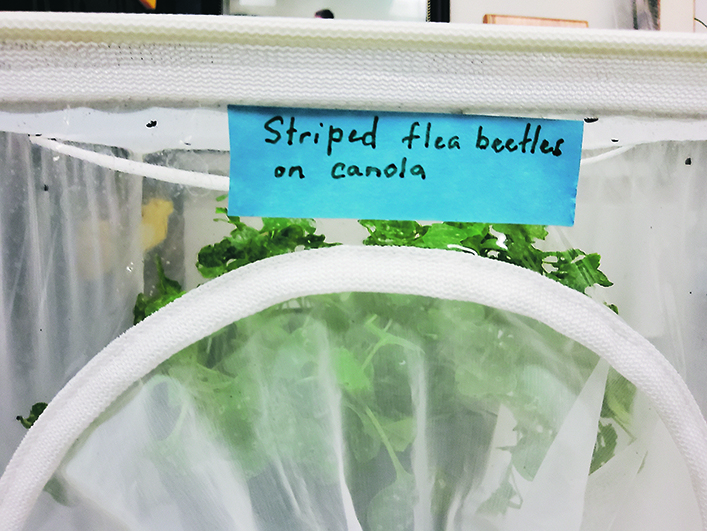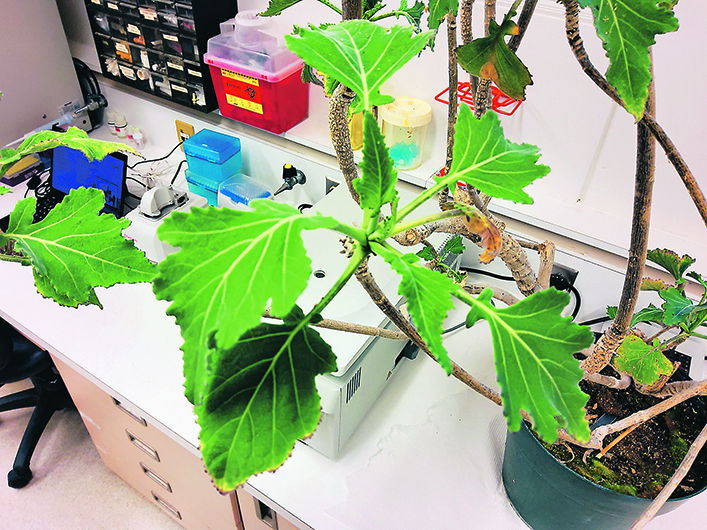Scientist takes research in a different direction as efforts continue to breed canola with plant hairs to fend off flea beetles
Plant hairs may provide better natural pest control than insecticides.
The knowledge that plants with plant hairs, called trichomes, are unpleasant to insects and animals is not new but using it to make canola undesirable to flea beetles remains an ongoing challenge. Varieties of hairy canola have been in development for more than 20 years. Development is slow going because gene crossing has been tricky.
Dwayne Hegedus, research scientist at Agriculture Canada, sees the light at the end of the tunnel, however.
The research began with Margaret Gruber and Julie Soroka, who created the original “hairy canola” from a cross of canola varieties like Westar and Arabidopsis thaliana, a close plant relative. The plant cross had hairy leaves but it proved unstable a few generations later, with some plants reverting to hairless.
There was also another issue.
Hegedus said Texas A&M University owns a patent on the Arabidopsis GL3 gene and a licence is required to use the gene in canola.
The research was also hindered by the industry itself, Hegedus added. Several chemical and seed companies expressed interest in the idea of hairy canola, but also knew that a natural insect defence could affect insecticide sales. Seed or pesticide companies were reluctant to fund it, he said.

Renewed interest emerged after the European Union banned neonicotinoid seed treatments, which has made it near impossible to grow canola in much of Europe. Meanwhile, the push for biofuels has led to increased interest in crops like canola that are suitable for biofuels.
When Hegedus joined the team in about 2018, he took the research in a different direction. He looked at Brassica villosa, a closer relative of canola, and thought it showed a lot of promise with its velvety leaves. The work focused on transferring the hairy and waxy leaf trait.
The research has experienced many ups and downs and progress has been slow. Conventional breeding takes time, and putting promising new lines through trials takes years.
A big component was also procuring a steady supply of flea beetles. After all, the point of the research was to see how they react to the presence of plant hairs on the leaves of their favourite meal.
Hegedus said entomologists from other universities have stepped up to help.

“After about 20 years of work… we finally have been able to establish a colony of flea beetles here at the centre. That means we can actively propagate flea beetles in the colony.”
Until six months ago, researchers had to collect both striped and crucifer flea beetles during a small window of time once a year and then hurriedly carry out experiments before the supply was depleted.
Plant hairs deter flea beetles because they follow several steps before they feed. The hairs disrupt the process, causing beetles to leave the plant. The added waxy trait that has also come out of Hegedus’s research has similar effects as the hairs, interrupting the steps the beetle needs to do before feeding.
The research, funded by the Canola Council of Canada, Agriculture Canada, the Canola AgriScience Cluster, and previously by the Manitoba, Saskatchewan and Alberta canola groups and other provincial government fund matching programs, has made strides toward a stable plant that consistently exhibits about 800 plant hairs per leaf.















